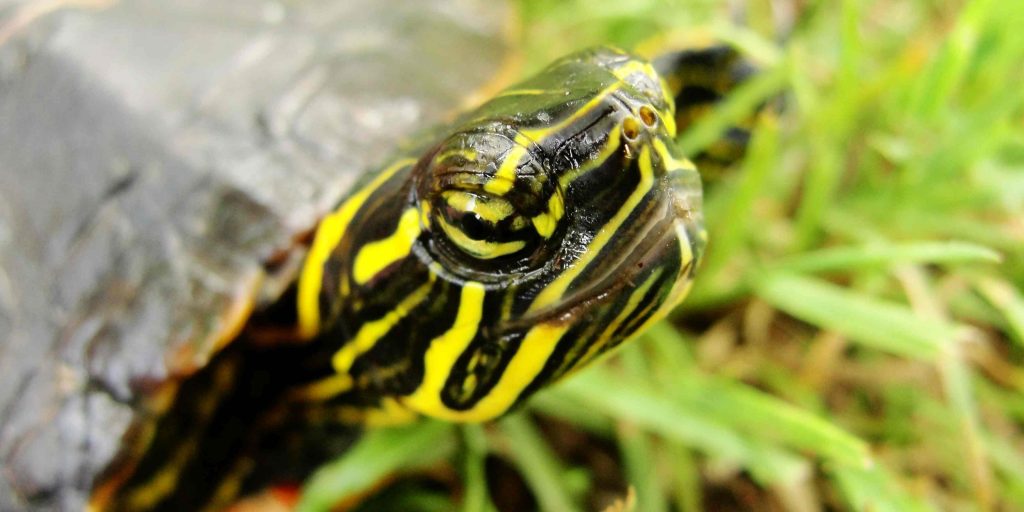
Anthropogenic influences on turtle populations
Many reptiles, including many turtle species, are increasingly impacted by human activity. Wild populations can be harmed by direct exploitation of the animals themselves, habitat loss and fragmentation due to development, pollution such as agricultural run-off, global climate change, and even recreational activities by humans, as well as a combination of these factors. A thorough understanding of the effects of these influences on populations, as well as the mechanisms by which populations might cope with their changing surroundings, is crucial for developing successful, cost-effective management and conservation strategies.
Our lab is addressing several of these important conservation issues through projects involving population monitoring in Blanding’s turtles (Kasuga & Janzen, 2008, Illinois DNR Report; Chandler et al., 2009, Illinois DNR Report) and in ornate box turtles (Terrapene ornata) (Bowen et al., 2004, J. Herpetol.); studying how anthropogenic activity influences turtle behavior and reproductive ecology (Kolbe and Janzen, 2002, Ecology; Bowen and Janzen, 2008, Chel. Conserv. Biol.; Strickland et al., 2010, J. Herpetol.); the effects of atrazine, an herbicide which has been shown to be an endocrine disruptor, on map turtles; and the effects of climate change on hibernation energetics (Willette et al., 2005, Can. J. Zool.), and on sex ratio and nesting behavior in species with temperature-dependent sex determination (Janzen, 1994, PNAS; Morjan, 2003, Am. Nat.; Schwanz and Janzen, 2008, Physiol. Biochem. Zool.; Huey and Janzen, 2008, Proc. R. Soc. Lond.; Mitchell and Janzen, 2009, Sex. Dev.).
Phylogenetics, molecular ecology, and phylogeography of North American reptiles
The structure of natural populations and the intraspecific relationships among these populations provides a crucial context for understanding the historical, current, and future evolution of organismal phenotypes. This fact is becoming increasingly clear to biologists of all stripes, and analysis of microsatellite markers and mtDNA and nuDNA sequences are providing the substrate to add a geneological perspective to such studies.
We are using this approach with various molecular techniques to evaluate the pedigrees and phylogenies of species and populations of certain North American reptiles. One project aims to resolve broad-scale phylogeographic patterns as well as local population genetic differentiation among populations of Blanding’s turtles (Emys blandingii) (Kasuga & Janzen, 2008, Illinois DNR Report; Chandler et al., 2009, Illinois DNR Report). Another uses a combination of genetic, morphological, behavioral, and geographic data to look at patterns of differentiation and isolation-by-distance in a complex of sympatric and allopatric map turtle (Graptemys) species to understand how both drift and selection have contributed to variation within and divergence between species (Myers, 2008, dissertation).
Past projects have involved reconstructing the relationships among isolated populations of vulnerable western pond turtles (Emys marmorata) to assess the extent of differentiation among these populations and to determine their conservation “status” (Janzen et al., 1997, Chel. Conserv. Biol.), and examining the inter- and intra-specific relationships of softshell turtles (Apalone) (Weisrock and Janzen, 2000, Mol. Phylog. Evol.; McGaugh & Janzen, 2008, Chel. Conserv. Biol.; McGaugh et al., 2008, Zool. Scripta) and reconstructing the evolutionary causes of clinal variation in thermal sensitivity of antipredator behavior. Other such molecular ecology and evolutionary studies in progress involve imperiled box turtles (Terrapene) (Kuo and Janzen, 2004, Conserv. Genet.; Howeth et al., 2008, Mol. Ecol.), hognose snakes (Heterodon), garter snakes (Thamnophis) (Janzen et al., 2002, Mol. Phylog. Evol.), and assessments of molecular systematics of painted turtles (Starkey et al., 2003, Evolution) and molecular phylogenetics and evolution among all recognized taxonomic families of extant turtles (Krenz et al., 2005, Mol. Phylog. Evol.; Chandler and Janzen, 2009, Copeia).
We are also employing microsatellite markers to evaluate the breeding structure (e.g., multiple paternity) of painted turtles (Pearse et al., 2001, Heredity and Mol. Ecol.; 2002, Behav. Ecol. Sociobiol.; McGaugh and Janzen, 2010, Behav. Ecol. Sociobiol.). We are greatly expanding our work in this and related areas of ecological genetics.
Life-history evolution and functional ecology of reptiles
Egg and offspring size, as well as other morphological and behavioral performance traits, play important roles in life-history models yet they vary greatly both within and among populations and taxa and temporally (Tucker et al., 1998, J. Herpetol.; Bowden et al., 2004, Funct. Ecol.; Schwanz et al., 2009, Ecology; Janzen and Warner, 2009, J. Evol. Biol.).
We have investigated physiological mechanisms underlying this variation in snapping turtles (Janzen et al., 1990, J. Exp. Zool.) and in painted turtles (Harms et al., 2005, Physiol. Biochem. Zool.), differences in size variation between sympatric populations of map turtles (Graptemys) (Janzen et al., 1995, Funct. Ecol.), the heritability of shell shape variation in red-eared sliders (Myers et al., 2006, Evolution), the relationship of this variation to offspring performance in smooth softshell turtles (Apalone mutica) (Janzen, 1993, Physiol. Zool.; Ashmore and Janzen, 2003, Oecologia; Mullins and Janzen 2006, Herpetologica), painted turtles (Colbert et al. 2009, Funct. Ecol.), and red-eared sliders (Myers et al., 2007, Funct. Ecology), and the impact of this whole process on offspring fitness during a crucial stage of the life history of snapping turtles (Janzen, 1993, Ecology; Kolbe and Janzen, 2001, Funct. Ecol.), painted turtles (Paitz et al. 2007, Biol. Let.), and red-eared slider turtles (Janzen et al., 2000, Ecology and J. Evol. Biol.; Filoramo and Janzen, 2002, Herpetologica; Janzen et al., 2007, Funct. Ecol.; Tucker et al., 2008, Behav. Ecol.).
We are actively continuing studies in various species to further elucidate the relationships between developmental environment, hatchling morphology, performance, and ultimately fitness (Tucker et al., 1999, Am. Midl. Nat.; Spencer et al., 2006, Ecology). Additional experiments have been or will be conducted to evaluate the causes of natural selection on offspring size using both size-manipulated hatchling Trachemys and soft plasticine replicas that “record” predation attempts.

A legacy of conservation; a commitment to sustainability.
3700 E. Gull Lake Drive
Hickory Corners, MI 49060
(269) 671-5117
info@kbs.msu.edu